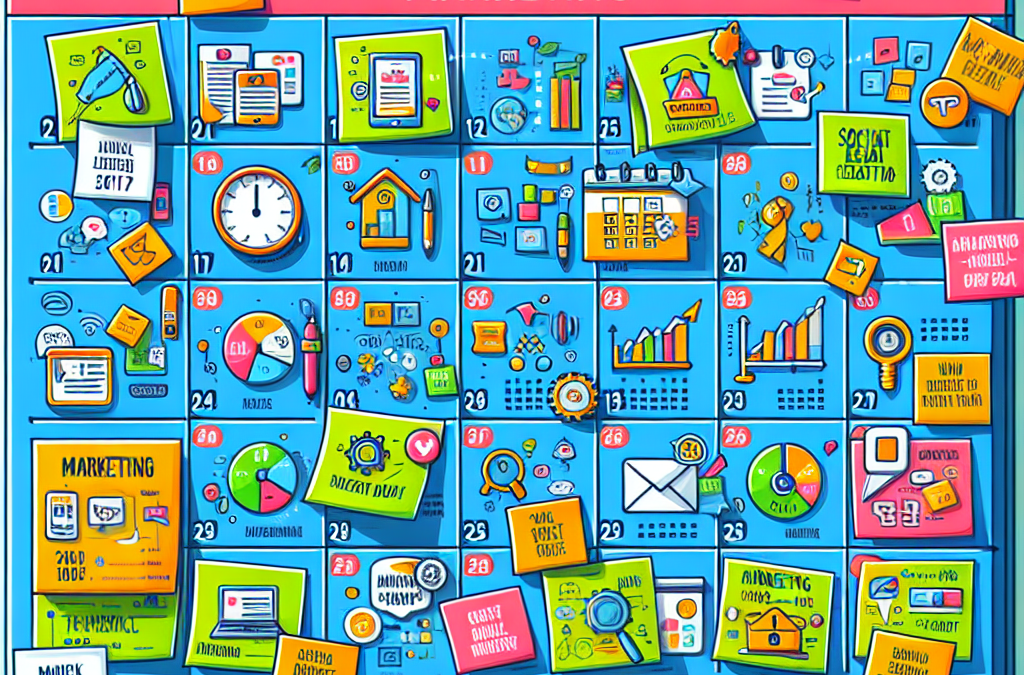Define Your Marketing Goals
Understand Your Business Objectives
When I first set out to create a local marketing calendar, I realized it was crucial to start with understanding my business goals. Is your aim to increase brand awareness, drive traffic to your website, or boost in-store sales? Each of these goals requires a different approach in your marketing strategy.
Defining your marketing objectives not only helps in creating a targeted calendar, but it also aligns your team’s efforts. I’ve found that having clear goals enables us to measure success more effectively, and this is key in a local context where competition can be quite intense.
Remember, it’s not just about having goals, but having SMART goals: specific, measurable, achievable, relevant, and time-bound. This clarity can make a world of difference.
Identify Your Target Audience
Next up, knowing who you’re talking to is paramount. Who are your customers? What are their needs, desires, and pain points? Understanding your audience will inform every piece of content or campaign you plan.
In my experience, I often create customer personas based on demographics, interests, and purchasing behavior. This helps in tailoring our marketing messages to resonate with local customers. The more closely you can speak their language, the more likely they are to engage.
This takes time but trust me, the effort will pay off. Invest in surveys, social media insights, and customer feedback to really get a grip on who your audience is.
Set a Timeline for Your Campaigns
Once I have my goals and audience sorted, I set an overarching timeline for my campaigns. This step is where the rubber meets the road. I use a calendar to block out specific periods for each campaign, aligning them with local events and seasons that matter to my audience.
For example, if you have a local festival coming up, gear your marketing efforts around that. Plan promotions or events that coincide with it. Timing is everything in local marketing, and a well-planned timeline can create buzz and excitement.
Don’t forget to maintain flexibility in your timeline. The local market can be unpredictable, and being able to pivot is important. Sometimes, the best opportunities pop up when you least expect them!
Research Local Trends and Events
Stay Informed on Local Events
One of the things I’ve learned is to keep my ear to the ground when it comes to local happenings. Whether it’s community events, holidays, or even local news, these trends can greatly influence your marketing calendar.
By staying updated, I can align my campaigns with these events. For instance, if there’s a charity run happening in your town, consider sponsoring it or participating. This not only boosts local visibility but also enhances your brand image as a community supporter.
I make it a habit to follow local blogs, social media pages, and community bulletins to stay informed. This proactive approach can provide a treasure trove of ideas.
Leverage Seasonal Opportunities
Another angle to look at is seasonal marketing trends. When summer rolls in, everyone’s looking for fun activities, while winter brings holiday shopping season. I always brainstorm marketing ideas that tap into these seasonal shifts.
Seasonal promotions can be very effective. For example, launching a summer sales campaign with local themes can resonate well with your audience. Ask yourself: how can my business be part of the local culture during these times?
It’s also important to reflect local sentiments; if there is a local sports team making waves, why not incorporate that into a campaign? Tailoring your marketing to these seasonal opportunities can create a genuine connection with your audience.
Use Insights from Past Campaigns
Looking back at previous marketing efforts can reveal strong insights into what works and what doesn’t. I often analyze past campaign data, especially those tied to local initiatives, to refine my approach.
What were the most successful promotions? What did the local community respond well to? Gathering this data can provide a roadmap for future campaigns. If something flopped, it’s just as critical to understand why and to course-correct moving forward.
Tools like Google Analytics and social media insights can help in compiling this information. Remember, the past isn’t just a tutor; it’s a treasure trove of knowledge.
Plan Content and Campaigns
Create Engaging Content
Now, let’s chat about content. Creating engaging content is at the heart of any marketing calendar. I like to brainstorm a variety of content types to connect with my audience—blogs, videos, social media posts, and newsletters should all reflect your brand and resonate with local interests.
I always focus on storytelling. Share stories about your brand’s involvement in the community, spotlight local customers or partners, and highlight events that make your town unique. This personal touch can create deeper connections with your audience.
Be consistent with your voice and message across all platforms. Building a relatable brand image takes time, but once you have it, your audience will feel more connected to your content.
Establish Clear Call-to-Actions
Every piece of content you create should have a clear call-to-action (CTA). Whether it’s visiting your website, signing up for an event, or making a purchase, I’ve found that guiding your audience on what to do next can lead to better engagement and conversions.
Incorporating local CTAs, like “Join us at the local fair!” or “Check out our store in Downtown!” can strengthen your local presence. It’s about inviting people to interact with your brand, both online and offline.
It helps to test different CTAs to see which resonates best with your audience. Don’t hesitate to get creative and think outside the box!
Schedule Your Campaigns Effectively
Finally, it’s time to schedule everything in your calendar. I visualize my marketing calendar as a roadmap, plotting out each campaign and aligning it with my promotional content. This helps avoid overlaps and ensures I’m not putting multiple campaigns out at once, which can dilute the impact.
Using tools like Google Calendar or Trello can keep your scheduling organized. I’ve developed a fondness for color coding my campaigns, which makes it easy to see what’s coming up and when. It’s basically a visual representation of my marketing efforts and helps me stay on track.
Lastly, remember to allow time for post-campaign analysis. It’s important to assess the performance of your campaigns, learn from them, and celebrate your wins!
Evaluate and Adjust Regularly
Measure Success with Analytics
No marketing calendar would be complete without the evaluation phase. After a campaign closes, I jump into analytics to see how we did. Metrics like website traffic, engagement rates, and sales conversions tell the story of our efforts.
I often set KPIs beforehand so I know what to focus on during this evaluation stage. For instance, if I’m looking to increase foot traffic, I’ll be especially focused on in-store sales data compared to my usual digital metrics.
This part is crucial because it reveals areas needing improvement. You can learn from successes and failures alike, and adjust accordingly for your next campaign!
Gather Feedback from Customers
While numbers are great, sometimes customer feedback is golden. After running a local campaign, I like to invite feedback from customers through surveys or social media polls. Hearing directly from them gives insights that data can’t always provide.
Questions like “What did you like best about our recent promotion?” or “How did our campaign resonate with you?” can yield valuable insights. People appreciate when brands listen and respond.
This ongoing dialogue not only informs future marketing strategies but strengthens your relationship with your audience, making them feel valued.
Adapt to Changes in the Market
Lastly, I believe you must stay flexible and open to change. The local market is always evolving, and staying ahead requires adapting your strategies accordingly. Whether new competition arises or consumer preferences shift, remain agile in your marketing approach.
I enjoy setting aside time each quarter to review my marketing landscape, focusing on emerging trends that could impact my audience and my campaigns. This proactive approach allows me to pivot when necessary and seize new opportunities.
Ultimately, your marketing calendar should be a living document, one that evolves and grows with your business and market needs.
FAQ
1. What is a local marketing calendar?
A local marketing calendar is a strategic plan that outlines marketing activities and campaigns specific to a geographical area. It helps businesses align their marketing efforts with local events, trends, and customer behaviors.
2. Why is defining marketing goals important?
Defining marketing goals is crucial because it provides direction and clarity. It ensures that all marketing efforts are aligned and measurable, making it easier to determine what strategies are working.
3. How can I identify my target audience effectively?
Identifying your target audience involves creating customer personas based on demographics, interests, and behaviors. Conducting surveys and analyzing social media insights can offer deeper understanding.
4. What tools can I use to create and manage my marketing calendar?
There are several tools like Google Calendar, Trello, and Asana that can help in scheduling and organizing your marketing campaigns effectively. These tools often have collaborative features too, which is great for teamwork!
5. How often should I evaluate my marketing efforts?
It’s advisable to evaluate your marketing efforts regularly, ideally after each campaign. This allows you to gauge success, learn from data, and make necessary adjustments in a timely manner.
This article offers a personal, practical guide to creating a local marketing calendar, leveraging my experiences while ensuring readability and engagement. Each section builds on the previous one, providing a comprehensive approach to developing a strategic marketing plan for local audiences.


